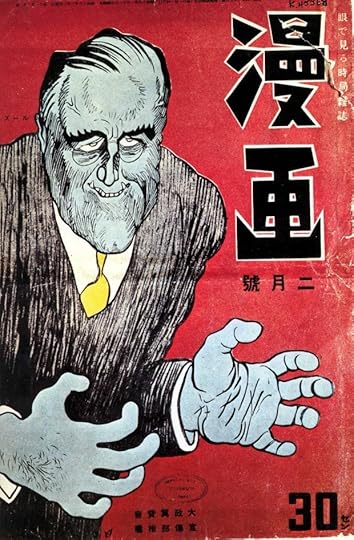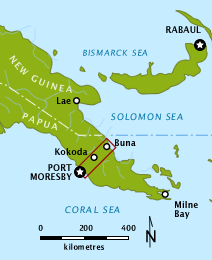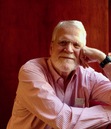Mark Scott Smith's Blog: Enemy in the Mirror, page 109
August 13, 2014
FDR with Fangs – 1942

via: https://farm7.staticflickr.com/6089/6...
Japanese propaganda posters and leaflets often characterized Allied leaders as demonic.
The post FDR with Fangs – 1942 appeared first on Enemy in the Mirror.
August 11, 2014
The Mask of Nippon – 1942
Racial stereotypes predominated in Allied propaganda about Imperial Japan.
This rather heavy-handed propaganda film was part of the National Film Board of Canada’s 1942 World in Action series.
Modeled after the popular American March of Time newsreels it was distributed by United Artists.
The post The Mask of Nippon – 1942 appeared first on Enemy in the Mirror.
August 8, 2014
World At War – June 1942
This fascinating propaganda film by the Office of War Information was apparently finished just before the Battle of Midway in June 1942.
It was a time when the Allies were losing all across the globe.
The film is 43 min. - bit long for this blog, but quite worth it to get a sense of the events leading up to American involvement in WWII and the mood at the time.
The post World At War – June 1942 appeared first on Enemy in the Mirror.
August 6, 2014
Food Rationing – USA 1942
Watch these “bad girls” learn a lesson about patriotism and war time rationing.
This is a great example of wartime government/film industry public service films.
The post Food Rationing – USA 1942 appeared first on Enemy in the Mirror.
August 4, 2014
Estimated Total WWII Dead = 48,231,700
August 1, 2014
Bombing Civilians – 1942

B-17; Wikimedia Commons
At the beginning of WWII there was widespread consensus that a deliberate attack on civilians was immoral and against international law. Initial Royal Air Force attempts to execute precision daylight bombing against German targets and minimize civilian casualties proved relatively ineffective and very costly in loss of aircraft and crews. In February 1942, after Arthur “Bomber” Harris assumed leadership of British Bomber Command, RAF tactics changed. Attacks were now focused on the enemy civilian population with the intention of breaking morale.
After the USA entered WWII, the United States Army Air Force initially insisted on daylight precision bombing missions. In July 1942, the USAAF 8th Air Force carried out the first U.S. bombing mission in occupied Europe against a railroad yard in France. The daylight mission with B-17 flying fortresses was successful in hitting military targets without significant civilian casualties. There were no aircraft losses. This early success strengthened the American position on daylight precision bombing. For a while, the RAF area bombed at night and the USAAF carried out daylight precision bombing.
Gradually, the USAAF position weakened as daylight raids, without the protection of long-range fighter escorts, led to staggering losses. Soon the USAAF joined the RAF in nighttime area bombing aimed at civilian populations.
Germany and Japan also bombed civilians in WWII, but on a much smaller scale than Great Britain and the USA. Whether civilian bombing was an effective Allied strategy or not is still debated. Many (including Winston Churchill, an early proponent) came to question its value and morality. Many feel that German civilian resolve was actually strengthened by civilian bombing. Imperial Japan, clearly having lost the war, would not surrender until two large cities were destroyed by atomic bombs.
How does one draw the line between necessity and atrocity?
The post Bombing Civilians – 1942 appeared first on Enemy in the Mirror.
July 30, 2014
Sleepy Lagoon murder – August 1942
In 1942, many white citizens of California, stoked by media reports of a “Mexican crime wave,” expressed racial animosity against the Mexican-American community. When José Gallardo Diaz was found dying on a road near a local swimming hole (known as the Sleepy Lagoon) on the morning of August 2, 1942, Los Angeles newspaper reports of this “Sleepy Lagoon murder” implied that his killing was related to Pachuco gang acivity.
Although his autopsy showed that Díaz was intoxicated and suffered blunt head trauma compatible with being hit by a car, 25 members of the “38th Street gang” were arrested for alleged murder.
A subsequent media campaign calling for action against “zoot suiters” led to a police roundup of 600 Latinos who were charged with suspicion of assault, armed robbery, and related offenses; 175 were eventually held for various crimes.
.
The post Sleepy Lagoon murder – August 1942 appeared first on Enemy in the Mirror.
July 28, 2014
Stalingrad – July 1942

Stalingrad; Wikimedia Commons
During the German 1942 summer offensive (Operation Braunschweig) Hitler outlined new goals with the Führer Directive No. 45 of July 23, 1942. Here is an excerpt:
The task of Army Group B is, as previously laid down, to develop the Don defenses and, by a thrust forward to Stalingrad, to smash the enemy forces concentrated there, to occupy the town, and to block the land communications between the Don and the Volga, as well as the Don itself.
Closely connected with this, fast-moving forces will advance along the Volga with the task of thrusting through to Astrakhan and blocking the main course of the Volga in the same way.
These operations by Army Group B will be known by the cover name “Heron”.
Security: Most Secret.
The post Stalingrad – July 1942 appeared first on Enemy in the Mirror.
July 25, 2014
Ernie Pyle – “GI Joe” War Correspondent

Ernie Pyle; Wikimedia Commons
Ernest Taylor “Ernie” Pyle was a roving correspondent who reported from Europe and the Pacific theaters during WWII. Writing wartime columns from the perspective of the common GI, Pyle was enormously popular in WWII USA and won the Pulitzer Prize in 1944.
In April 1945 Pyle was killed on an island near Okinawa when his jeep came under Japanese machine gun fire.
_______________________
Excerpt from The Death of Captain Waskow
AT THE FRONT LINES IN ITALY, January 10, 1944
“…This one is Captain Waskow,” one of them said quietly.
Two men unlashed his body from the mule and lifted it off and laid it in the shadow beside the low stone wall. Other men took the other bodies off. Finally there were five lying end to end in a long row, alongside the road. You don’t cover up dead men in the combat zone. They just lie there in the shadows until somebody else comes after them.
The unburdened mules moved off to their olive orchard. The men in the road seemed reluctant to leave. They stood around, and gradually one by one I could sense them moving close to Capt. Waskow’s body. Not so much to look, I think, as to say something in finality to him, and to themselves. I stood close by and I could hear.
One soldier came and looked down, and he said out loud, “God damn it.” That’s all he said, and then he walked away. Another one came. He said, “God damn it to hell anyway.” He looked down for a few last moments, and then he turned and left.
Another man came; I think he was an officer. It was hard to tell officers from men in the half light, for all were bearded and grimy dirty. The man looked down into the dead captain’s face, and then he spoke directly to him, as though he were alive. He said: “I’m sorry, old man.”
Then a soldier came and stood beside the officer, and bent over, and he too spoke to his dead captain, not in a whisper but awfully tenderly, and he said:
“I sure am sorry, sir.”
Then the first man squatted down, and he reached down and took the dead hand, and he sat there for a full five minutes, holding the dead hand in his own and looking intently into the dead face, and he never uttered a sound all the time he sat there.
And finally he put the hand down, and then reached up and gently straightened the points of the captain’s shirt collar, and then he sort of rearranged the tattered edges of his uniform around the wound. And then he got up and walked away down the road in the moonlight, all alone.
After that the rest of us went back into the cowshed, leaving the five dead men lying in a line, end to end, in the shadow of the low stone wall. We lay down on the straw in the cowshed, and pretty soon we were all asleep.
___________________________
The post Ernie Pyle – “GI Joe” War Correspondent appeared first on Enemy in the Mirror.
July 23, 2014
Japanese Advance Overland New Guinea – July 1942

Wikimedia Commons
Occupation of Port Moresby New Guinea would have provided Japan a springboard for the invasion of Australia. In early 1942, after establishing a base at Rabaul, New Britain, Japan began landing troops on the north coast of New Guinea. In July, after plans for a direct naval attack on Port Moresby were disrupted by the Battle of the Coral Sea, Japanese troops landed along New Guinea’s northeast coast with a plan to advance south over the Owen Stanley Range and seize Port Moresby. Pressing inland , they soon captured the airfield at Kokoda from an undermanned Australian force after heavy fighting.
The post Japanese Advance Overland New Guinea – July 1942 appeared first on Enemy in the Mirror.
Enemy in the Mirror
I began by posting events around the turn This website www.enemyinmirror.com explores the consciousness, diplomacy, emotion, prejudice and psychology of 20th Century America and her enemies in wartime.
I began by posting events around the turn of the 20th century as I was researching my first novel about the Pacific War. I continued through WWII for my second novel about the Battle of the Atlantic. Now I am beginning to look at the Cold War as I gather information for my next novel about the Korean War. ...more
- Mark Scott Smith's profile
- 7 followers







